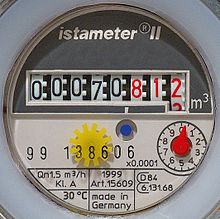Counter


A counter is a device for recording (and mostly also displaying) numbers and quantities. There are two basic types of pulse and quantity counters (or event and piece counters). A pulse counter counts individual events such as mechanical shock movements ( hand counter ) or electrical pulses . A quantity counter counts continuously changing variables such as the distance traveled by a vehicle (displayed as the mileage).
Counting capacity
The counting capacity, i.e. the total number c of the possible display values, is determined by the number of cascaded counting levels and the number of digits per counting level for all counter types
given.
Continuing counting after the counter has reached the highest reading results in the simplest case, that the display starts again at zero (so-called overflow ). However, the counter can e.g. B. also be set up so that the display then stops at the highest level.
Designs
Counters work mechanically, electromechanically or electronically.
Mechanical counters
The oldest counter types work mechanically. A roller counter , formerly also called totalizer , consists of several rollers on one axis. A mechanism is used to turn the first roller through a defined angle, usually 1/10 of a turn, and locks in the next position. Each roller has a single tooth, which is used to turn the next roller 1/10 of a turn at the end of a full turn. The numbers from 0 to 9 are applied to the rollers; In this case, the transfer takes place between the digits 9 and 0. The position of all roles can be read off directly as a decimal number.
In the case of volume counters, the counter is not driven by a defined angle, but steplessly via a gear . If more digits are to be displayed than are necessary for business purposes (for example , digits only required for calibration purposes ), these can also be displayed on a scale instead of on a number roller . In the case of total acquisition (for example volume measurement from a flow ), the least significant digit often rotates continuously.
Electromechanical counters
Electromechanical counters are mechanical counters with an electric drive. When individual events are recorded, an electrical impulse activates an electromagnet or electric motor , which continues to turn the lowest-valued numerical roller. In the case of cumulative acquisition (for example energy measurement from an active power ), acquisition is continuous.
Electronic counters
Electronic decimal counters used to be realized with counter tubes . Today counters are built with integrated circuits (ICs) in many variants. They are always pulse counters because they work incrementally (see digital measurement technology ). The elementary components of an electronic counter are edge - controlled flip - flops . They are interconnected for counting in the dual system or decimal system .
Software counters
With the progressive relocation of functions from special components to microprocessor-based systems, counters are increasingly being simulated by programs . Although computers also contain real digital counters, software counters are simulated by a program as it is noted here in pseudocode :
:= 0 Schleife Anfang Warte auf Ereignis := Schleife Ende
The variable is set to 0 at the beginning of the program. The following instructions are repeated endlessly: The computer is waiting for the event to be counted to occur. If the event occurs, the variable is increased by one.
Applications
Totalizer
Classic examples of quantity counters are odometers in vehicles. Until the end of the 1980s they were almost without exception mechanical, but have now been implemented electronically in almost all vehicle types. Simple odometers counted back when driving back (or turning the coupled front wheel accordingly). A backstop or a gear that rectifies the direction of rotation prevents this possibility of forgery. Early VW Beetles had five-digit counters that indicated "00000" again at 100,000 kilometers.
Also, water meters , heat meters , electricity meters , gas meters , hour meter and measuring wheels , as they are used to survey the situation of road traffic accidents or unwound by the meter, are meter.
On paper or tin snips, a mechanical counter that counts in both directions can show the position of the stop to the millimeter and more precisely if the setting point is always approached in the same direction to avoid play.
In laboratories there are counters on the setting knob for multi-turn precision rotary resistors.
Totalizers often have a continuously rotating number wheel at the lowest point. If a digit is halfway up here, this and the following digit can only be read halfway. To make it easier to see, the reading window on some electricity meters is a little higher at this point. When "counting" from "9" to "(1) 0", the next higher digit also moves slowly and synchronously. As a result, the counting from 99,999 to (1) 00,000 on the vehicle odometer is conspicuously visible to 5 digits simultaneously and synchronously and is very gradual over a distance of 1 kilometer. Due to mechanical play, the row of nine lies on a slightly sloping line.
Pulse counter
Pulse counters are, for example, the charge unit counters on telephones. Until the 1990s, these were mostly separate electromechanical meters for telephone customers. The electromechanical counters in the telephone exchange were photographed in blocks for billing purposes. Today, a function implemented with software counters and clocking and integrated into the telecommunications systems is used. A characteristic of pulse counters is that the digit at the lowest point always jumps forward to the next higher number.






